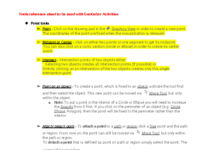Intro 2: GeoGebra skills, terms, vocabulary & postulates
About this activity
Tools reference sheet to be used with GeoGebra Activities - the tools we will use in this activity are highlighted. ****use Ctrl + Shift + Click to open a link in a new tab ***
Getting comfortable with some tools of GeoGebra, some postulates and vocabulary.
Some of the questions will talk about congruence. Watch this short video before you answer the questions.
1. Short answer
We encountered 2 postulates in this activity: 1. Through 2 points there is exactly one line 2. if two lines intersect, then they intersect in exactly one point. In your own words describe what each postulate is saying.
2. Definition
A radius of a circle is a segment whose endpts are the center of the circle and a point on the circle. A diameter is a chord that contains the center of the circle. Define, chord (of a circle)
3. Definition
Define, ray.
4. Short answer
In plane geometry we have three undefined terms one is "plane" ( a 2-dimensional surface that extends out indefinitely into space), what are the two other undefined terms mentioned in this activity.
5. Definition
Define, postulate.
6. Definition
Define, segment.
7. Explain
Explain why the following statement must be true: in a circle or in congruent circles, radii or diameters are congruent. (make sure to watch the video that explains congruent figures)
8. Define
Define, midpoint.
9. Fill-in
a. A circle has ________ radii and diameters. b. A segment has ________ midpoint(s). c. A line has ______ midpoint(s). possible answer choices: zero, one, two, three, infinite (unlimited)
10. Definition
Define, midpoint
11. Definition
Define, congruent (figures)
